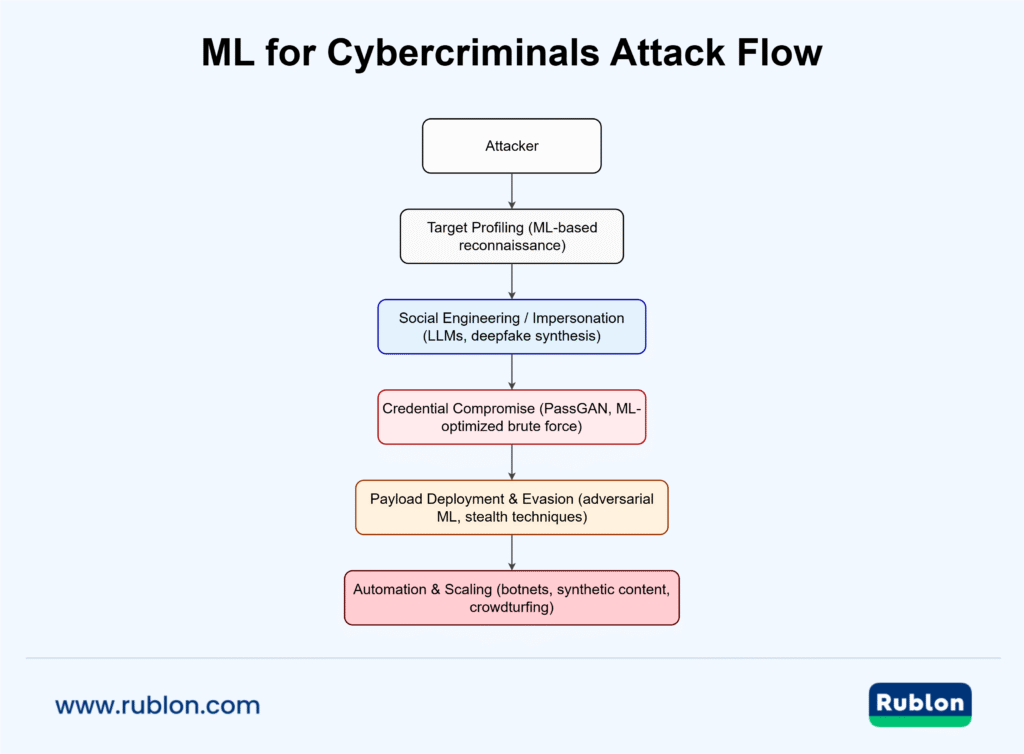Machine learning (ML) and generative AI have rapidly lowered the technical bar for sophisticated attacks: easier access to large language models, open-source ML tooling, and on-demand compute mean attackers can prototype scams and evasion techniques faster than before. Government and industry reports highlight that AI is now a material factor in criminal tactics and that defenders must adapt.
What Is ML-Powered Cybercrime, and Why It Matters Now
Definition: Use of ML/AI by adversaries to improve reconnaissance, craft more convincing social engineering, evade detection, guess credentials, and automate operations.
Why now: Pre-trained LLMs, widely available voice/video synthesis, and affordable compute allow attackers to do at scale what once required specialists, creating higher-volume, higher-quality attacks.
The Attack Lifecycle — Where ML Typically Fits
- Reconnaissance / Information Gathering: ML helps classify targets, extract likely weak points from public data, and prioritize victims.
- Impersonation / Social Engineering: LLMs and generative models craft personalized phishing and deepfakes for voice/video social engineering.
- Credential compromise / Unauthorized access: ML is used for smarter password guessing and CAPTCHA bypass research.
- Attack / Payload Delivery: adversarial ML enables evasion of ML-based detectors and generation of more plausible malicious content.
- Automation / Post-exploitation: ML-driven automation (botnets, crowdturfing) scales impact and reduces human labor.

Reconnaissance / Information Gathering
- ML models can classify harvested social media, job posts, and corporate signals to find high-value targets or employees with access.
- Clustering/classifiers (topic models, embeddings), LLM prompt pipelines that summarize public footprints into attackable profiles.
- Prioritizes targets for manual follow-up or automated campaigns, reducing wasted effort and increasing success rates.
Impersonation / Social Engineering
- LLMs produce tailored phishing/spear-phishing copy at scale and can produce follow-ups; voice/video deepfakes amplify social engineering (vishing/video-call fraud).
- Real incidents: high-profile deepfake scams and attempted CEO impersonations show practical use of cloned voices and synthetic video in fraud.
Credential Compromise / Unauthorized Access
- Generative models like PassGAN show ML can produce plausible password guesses that complement traditional cracking rules; reinforcement or generative models can accelerate credential-guess lists.
- Attackers may also use ML to optimize brute-force sequences and adapt guessing strategies from leaked breach datasets.
Mitigate ML hacking. Sign up for a Free 30-Day Rublon Trial →
Attack / Payload Delivery
- Adversarial techniques (e.g., MalGAN) demonstrate how ML can craft payloads or inputs designed to evade ML-based detectors (antivirus or other classifier systems).
- Attackers can combine social engineering (LLM) with adversarial payloads to both deliver and hide malware, increasing persistence chances.
Automation / Post-Exploitation
- Hivenet-style botnets, automated crowdturfing, and AI-driven review generation let attackers monetize at scale (e.g., fake reviews, coordinated reputation attacks).
- Automation reduces operator costs and increases campaign speed; however, orchestration quality still matters (quality vs. quantity tradeoff).
Techniques & Examples
- Phishing / LLMs: automated spear-phishing using Markov/NN/LLM text generation; Black Hat demos show high click rates in experiments.
- Deepfakes: voice-cloning fraud (CEO voice scam, 2019) and 2024–25 high-profile deepfake attempts against executives.
- Adversarial ML / MalGAN: GAN-based methods to make malware evade black-box detectors.
- PassGAN / credential models: GANs trained on breach leaks to produce realistic password guesses.
- Crowdturfing / fake content: generative AI for content/review creation and bot-run micro-interactions.
Challenges & Constraints for Attackers
- Data & cost: realistic model training needs data (breach dumps, voice samples) and compute, but cloud credits/leases lower the entry cost.
- Model limitations: overfitting, poor generalization, and transferability limits mean some ML attacks require tailoring.
- Detectability & defenses: anomaly detection, watermarking, and adversarial defenses raise detection costs for attackers.
Defensive Strategies & Mitigations
- Use ML for defense: deploy anomaly detection, EDR/behavioral baselines, and AI-assisted threat hunting to raise detection rates.
- Adversarial ML defenses: adopt robust modeling, input sanitization, and continuous model validation to reduce evasion risk.
- Operational controls: multi-factor authentication (MFA), privileged-access management, strict segmentation, and phishing-resistant authentication remain high-value controls.
People & process: targeted user training, red-teaming with synthetic adversarial content, and logging + rapid response improve resilience.
Looking for a FIDO MFA Provider?
Protect Active Directory and Entra ID users from hackers with phishing-resistant FIDO security keys and passkeys.
Trends & Outlook
- Fusion AI + threat intel: automated model-assisted threat hunting and rapid extraction of IOC patterns from streaming telemetry.
Federated & synthetic data: attackers and defenders both use synthetic/federated data to train models while avoiding attribution or leaks.
Dual-use generative AI: generative systems will be simultaneously the best attack enabler and a core defensive tool; governance, explainability, and model-hardening will be critical.
Immediate Checklist (3-step):
- Enforce MFA for all privileged access.
- Centralize logging/EDR and create alerts for anomalous content or unexpected file uploads.
- Conduct targeted red-team simulations using generative phishing and voice deepfakes.
Conclusion
ML is not a magic wand for attackers, but it is a force multiplier — enabling faster reconnaissance, more convincing impersonation, and scalable automation. Defensive priorities are simple and concrete: harden auth (MFA), apply behavioral detection and EDR, segment networks, centralize logging, run AI-aware red teams, and keep patching and vendor controls tight.
